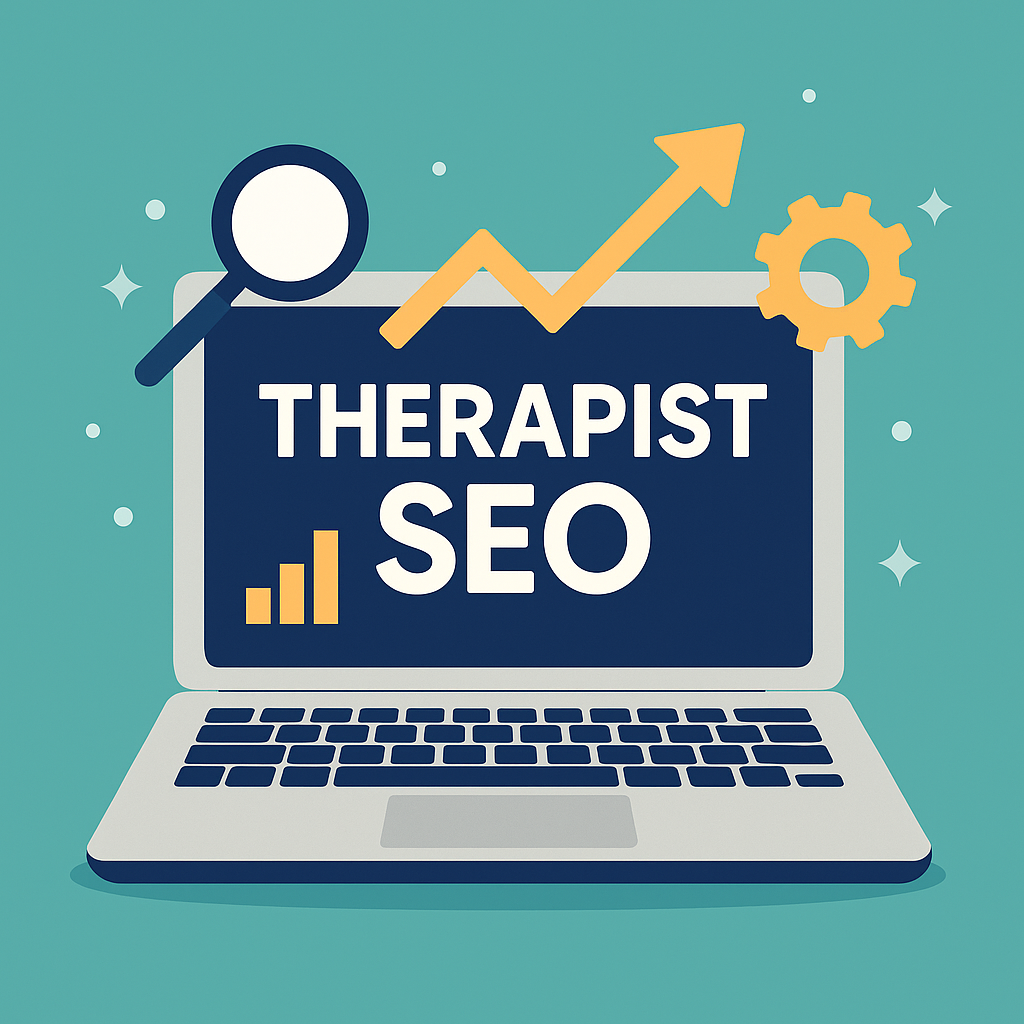So what are the top 7 ways to rank your therapist website on Google in 2025?

Growing a private practice in 2025 means showing up where anxious insomniacs and stressed-out parents are already searching: Google. The good news? You do not need to become an SEO wizard or code ninja. The better news? A handful of focused moves can push your site from page 4 obscurity into the Local 3-Pack that gets most of the calls.
Grab a coffee (or kombucha) and walk through these seven therapist-friendly steps. Written for humans, not robots, so you can climb the rankings and book more sessions.
Start with On-Page SEO You Can Control
Google’s own local-ranking studies still list classic on-page signals. Title tags, headings, internal links, as the biggest ranking lever you can pull yourself.
Do this today
- Title tag: Keep it under 60 characters. Lead with your main service + city (“Trauma-Informed Therapy in Denver | RiverMind Counseling”).
- H1: One per page, matching the service/search intent (“Denver Trauma Therapy”).
- Meta description: Under 160 characters, human-focused (“Evidence-based EMDR and somatic work. Free 15-minute consult.”).
- Sprinkle synonyms: “PTSD treatment,” “flashback relief,” etc., in your H2/H3 sub-heads.
- Internal links: Drop links from your anxiety page to your EMDR page, and from both back to your booking page. Google—and visitors—follow those threads.
Give Google the Page Experience It Wants
Since the Page Experience & Core Web Vitals update, Google rewards sites that load fast, wiggle less, and run smoothly on phones.
Your quick wins
- Compress hero images (free tools like TinyPNG).
- Use a lightweight WordPress theme or Squarespace template.
- Keep mobile load time under two seconds—check PageSpeed Insights.
- Set width/height on images so text doesn’t jump (CLS).
- Make sure your site is HTTPS (secure padlock).
None of this is glamorous, but it does keep you visible when two local competitors are equally relevant.
Treat Google Business Profile Like a Second Homepage
For local searches, Google Business Profile (GBP) signals account for over 30 percent of pack rankings.
Five-minute GBP checklist
- Choose the exact category (“Psychotherapist” or “Marriage Counselor”).
- List accurate hours. Google now shows “frequently updated” hours higher.
- Upload real office photos monthly (waiting room, telehealth setup, community talk).
- Post short Google Posts weekly: tip + CTA (“3 breathing exercises ? Book consult”).
- Ask every satisfied client for a review using HIPAA-safe language (no details).
Fresh photos + recent reviews = algorithm love and human trust.
Write People-First Content (Google’s Words, Not Ours)
Google’s Helpful Content system rewards pages that solve a searcher’s problem, not stuff a keyword.
How to keep it helpful
- Answer specific questions. “How long does CBT take to work for panic attacks?”
- Use long-tail keywords. Lower competition, higher intent (“EMDR therapist for first responders Chicago”).
- Keep it skimmable. Short paragraphs, bullet lists, takeaway boxes.
- Close with a CTA. “Ready to talk? Schedule a free call.”
Helpful beats clever. Always.
Earn Local Backlinks (No Fancy Outreach Needed)
Backlinks remain a top three ranking factor. Quality > quantity.
Easy backlink ideas
- Offer a 600-word guest post to a local wellness blog.
- Give a quick quote to a hometown journalist during Mental Health Awareness Month.
- Join your city’s chamber directory or a state psychological association list.
- Sponsor a local 5K and get a link from the event page.
One solid local link often beats ten spammy ones.
Add Local Business Schema & Keep Tech Clean
Structured data helps Google “read” your practice details. Name, location, hours, without confusion.
Action
- Generate JSON-LD LocalBusiness schema (free generator).
- Include coordinates and the same NAP (Name-Address-Phone) used on GBP.
- Submit an XML sitemap in Search Console.
- Fix crawl errors monthly.
This gives Google machine-level clarity so it can trust and rank you.
Track What Matters, Then Iterate
Ranking is pointless if nobody books. Combine Search Console, Analytics, and a spreadsheet (or CRM) so you can see:
| Metric | Tool | Why It Matters |
|---|---|---|
| Impressions & clicks | Search Console | Shows if you’re surfacing for the right terms. |
| Most-visited pages | Google Analytics | Reveals content worth pushing harder. |
| Leads per page | Your CRM | Connects SEO to revenue. |
Commit to one improvement per month. Swap a headline, compress images, add a review. Small compounding tweaks beat sporadic overhauls.
Two Therapist Websites to Learn From
| What They Nail | Example |
|---|---|
| Service-specific pages with keyword-rich H1s and internal links | Chicago Counseling Center — each condition (OCD, trauma, anxiety) gets its own optimized page and clear CTA. |
| Local + virtual target blend plus weekly blog posts answering real questions | Anchor Light Therapy Collective – Seattle — optimized for “virtual counseling WA,” fast mobile load, and consistent content drops. |
Peek at their structure: one headline, supportive subhead, scannable copy, single CTA button. Simple converts.
Wrap-Up: Your 2025 Therapist-SEO Checklist ?
- Tune titles, H1s, metas (on-page basics).
- Speed up & stabilize for Core Web Vitals.
- Polish GBP. Categories, reviews, posts, photos.
- Write helpful, question-answering content.
- Score local backlinks from real community sites.
- Add schema + fix crawl errors.
- Measure, tweak, repeat—one change per month.
Implement these seven moves and watch your practice move from page two to the local pack, and more importantly, watch your phone ring.
Interested in learning how to turn website traffic into clients for your therapy practice? Reach out to us to schedule a consultation call with our team, and we’ll help guide you.
